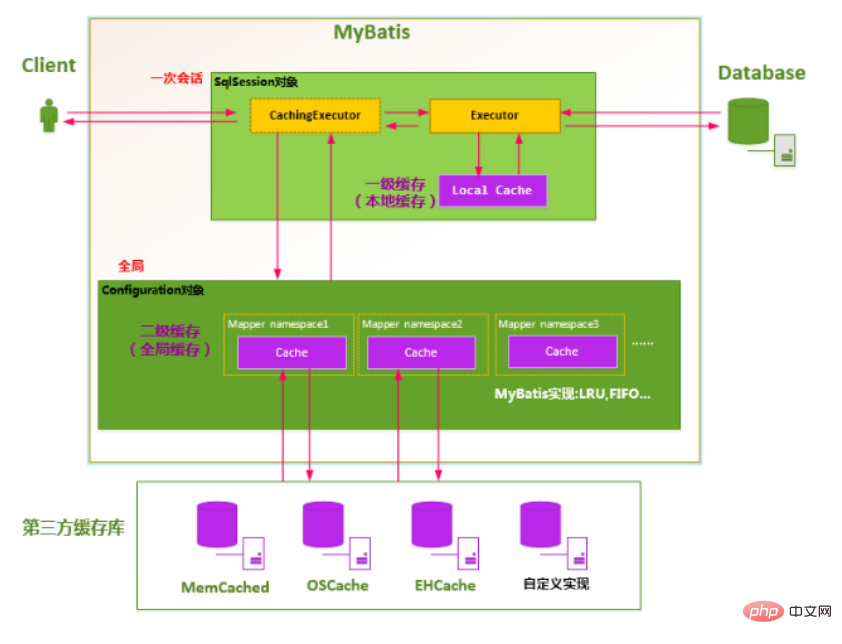 Java
Java
 javaTutorial
javaTutorial
 What is the difference between mybatis first-level cache and second-level cache?
What is the difference between mybatis first-level cache and second-level cache?
What is the difference between mybatis first-level cache and second-level cache?
The difference between the first-level cache and the second-level cache of mybatis: 1. The first-level cache of Mybatis refers to SQLSession. The scope of the first-level cache is SQlSession. Mabits enables the first-level cache by default; 2. Mybatis The second level cache is not enabled by default.

The operating environment of this article: Windows 7 system, MyBatis version 3.5.6, Dell G3 computer.
The difference between the first-level cache and the second-level cache of mybatis:
1) The first-level cache of Mybatis refers to SQLSession, and the scope of the first-level cache is SQlSession, Mabits enable first-level cache by default. In the same SqlSession, when executing the same SQL query; the first time it will query the database and write it in the cache, and the second time it will be fetched directly from the cache. When SQL is executed and additions, deletions, and modifications occur between the two queries, the SQLSession cache will be cleared.
Each query will first search in the cache. If it cannot be found, it will query the database and then write the results to the cache. Mybatis's internal cache uses a HashMap, and the key is the hashcode statementId sql statement. Value is the java object mapped to the query result set. After SqlSession performs insert, update, delete and other operations commit, the SQLSession cache will be cleared.
2) Second-level cache The second-level cache is at the mapper level. Mybatis does not enable the second-level cache by default. The first time the SQL under the mapper is called to query the user's information, the queried information will be stored in the second-level cache area corresponding to the mapper. In the second call to the mapper mapping file under the namespace, the same SQL is used to query user information, and the results will be retrieved from the corresponding second-level cache.

Related recommendations: java introductory tutorial
The above is the detailed content of What is the difference between mybatis first-level cache and second-level cache?. For more information, please follow other related articles on the PHP Chinese website!

Hot AI Tools

Undresser.AI Undress
AI-powered app for creating realistic nude photos

AI Clothes Remover
Online AI tool for removing clothes from photos.

Undress AI Tool
Undress images for free

Clothoff.io
AI clothes remover

Video Face Swap
Swap faces in any video effortlessly with our completely free AI face swap tool!

Hot Article

Hot Tools

Notepad++7.3.1
Easy-to-use and free code editor

SublimeText3 Chinese version
Chinese version, very easy to use

Zend Studio 13.0.1
Powerful PHP integrated development environment

Dreamweaver CS6
Visual web development tools

SublimeText3 Mac version
God-level code editing software (SublimeText3)

Hot Topics
 1669
1669
 14
14
 1428
1428
 52
52
 1329
1329
 25
25
 1273
1273
 29
29
 1256
1256
 24
24
 iBatis vs. MyBatis: Which one is better for you?
Feb 19, 2024 pm 04:38 PM
iBatis vs. MyBatis: Which one is better for you?
Feb 19, 2024 pm 04:38 PM
iBatis vs. MyBatis: Which should you choose? Introduction: With the rapid development of the Java language, many persistence frameworks have emerged. iBatis and MyBatis are two popular persistence frameworks, both of which provide a simple and efficient data access solution. This article will introduce the features and advantages of iBatis and MyBatis, and give some specific code examples to help you choose the appropriate framework. Introduction to iBatis: iBatis is an open source persistence framework
 Comparative analysis of the functions and performance of JPA and MyBatis
Feb 19, 2024 pm 05:43 PM
Comparative analysis of the functions and performance of JPA and MyBatis
Feb 19, 2024 pm 05:43 PM
JPA and MyBatis: Function and Performance Comparative Analysis Introduction: In Java development, the persistence framework plays a very important role. Common persistence frameworks include JPA (JavaPersistenceAPI) and MyBatis. This article will conduct a comparative analysis of the functions and performance of the two frameworks and provide specific code examples. 1. Function comparison: JPA: JPA is part of JavaEE and provides an object-oriented data persistence solution. It is passed annotation or X
 Detailed explanation of the Set tag function in MyBatis dynamic SQL tags
Feb 26, 2024 pm 07:48 PM
Detailed explanation of the Set tag function in MyBatis dynamic SQL tags
Feb 26, 2024 pm 07:48 PM
Interpretation of MyBatis dynamic SQL tags: Detailed explanation of Set tag usage MyBatis is an excellent persistence layer framework. It provides a wealth of dynamic SQL tags and can flexibly construct database operation statements. Among them, the Set tag is used to generate the SET clause in the UPDATE statement, which is very commonly used in update operations. This article will explain in detail the usage of the Set tag in MyBatis and demonstrate its functionality through specific code examples. What is Set tag Set tag is used in MyBati
 Various ways to implement batch deletion operations in MyBatis
Feb 19, 2024 pm 07:31 PM
Various ways to implement batch deletion operations in MyBatis
Feb 19, 2024 pm 07:31 PM
Several ways to implement batch deletion statements in MyBatis require specific code examples. In recent years, due to the increasing amount of data, batch operations have become an important part of database operations. In actual development, we often need to delete records in the database in batches. This article will focus on several ways to implement batch delete statements in MyBatis and provide corresponding code examples. Use the foreach tag to implement batch deletion. MyBatis provides the foreach tag, which can easily traverse a set.
 Detailed explanation of how to use MyBatis batch delete statements
Feb 20, 2024 am 08:31 AM
Detailed explanation of how to use MyBatis batch delete statements
Feb 20, 2024 am 08:31 AM
Detailed explanation of how to use MyBatis batch delete statements requires specific code examples. Introduction: MyBatis is an excellent persistence layer framework that provides rich SQL operation functions. In actual project development, we often encounter situations where data needs to be deleted in batches. This article will introduce in detail how to use MyBatis batch delete statements, and attach specific code examples. Usage scenario: When deleting a large amount of data in the database, it is inefficient to execute the delete statements one by one. At this point, you can use the batch deletion function of MyBatis
 Detailed explanation of MyBatis cache mechanism: understand the cache storage principle in one article
Feb 23, 2024 pm 04:09 PM
Detailed explanation of MyBatis cache mechanism: understand the cache storage principle in one article
Feb 23, 2024 pm 04:09 PM
Detailed explanation of MyBatis caching mechanism: One article to understand the principle of cache storage Introduction When using MyBatis for database access, caching is a very important mechanism, which can effectively reduce access to the database and improve system performance. This article will introduce the caching mechanism of MyBatis in detail, including cache classification, storage principles and specific code examples. 1. Cache classification MyBatis cache is mainly divided into two types: first-level cache and second-level cache. The first-level cache is a SqlSession-level cache. When
 Comparison of similarities and differences between iBatis and MyBatis: comparison of mainstream ORM frameworks
Feb 19, 2024 pm 07:08 PM
Comparison of similarities and differences between iBatis and MyBatis: comparison of mainstream ORM frameworks
Feb 19, 2024 pm 07:08 PM
iBatis and MyBatis are two mainstream ORM (Object-Relational Mapping) frameworks. They have many similarities in design and use, but also have some subtle differences. This article will compare the similarities and differences between iBatis and MyBatis in detail, and illustrate their characteristics through specific code examples. 1. The history and background of iBatis and MyBatis iBatis is Apache Software Foundat
 Sharing optimization tips for batch Insert statements in MyBatis
Feb 22, 2024 pm 04:51 PM
Sharing optimization tips for batch Insert statements in MyBatis
Feb 22, 2024 pm 04:51 PM
MyBatis is a popular Java persistence layer framework that implements the mapping of SQL and Java methods through XML or annotations, and provides many convenient functions for operating databases. In actual development, sometimes a large amount of data needs to be inserted into the database in batches. Therefore, how to optimize batch Insert statements in MyBatis has become an important issue. This article will share some optimization tips and provide specific code examples. 1.Use BatchExecu



